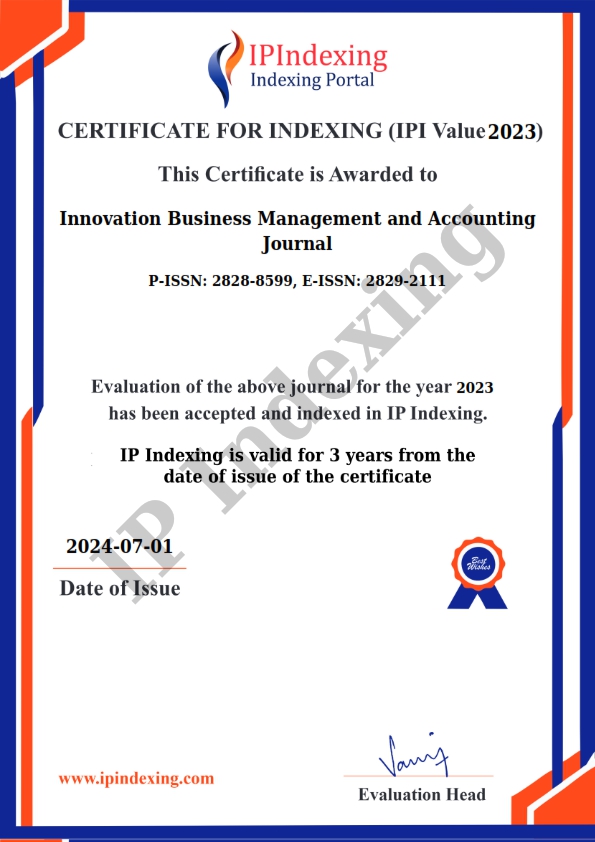User Behavior of Technology Towards Digital Samsat Services Use Technology Acceptance Model and Theory of Planned Behavior
DOI:
https://doi.org/10.56070/ibmaj.2024.052Keywords:
Ease, Quality, Security, Trust, UsefulnessAbstract
Digitalization of digital samsat applications such as Signal and NewSakpole, in this study the object is motor vehicle taxpayers in Banyumas Regency through the technology acceptance model and theory planned behavior approaches. This study aims to analyze the usefulness of digital applications for motor vehicle tax payments. The TAM and TPB models are frameworks for explaining the behavior of technology users towards digital samsat applications. The ease of using the digital Samsat application is expected to increase the effectiveness of the ease of tax payment transactions, compliance, and increase regional original income from the motor vehicle tax sector. This research is important to do because it has an impact on the ability to increase regional income from the PKB sector for one period or one year. The results of the study involving 108 respondents showed that the use of digital samsat applications is highly dependent on taxpayer behavior. Taxpayer behavior in this study was able to mediate the relationship between perceived usefulness and use of digital Samsat applications. This shows a change in the attitudes and behavior of taxpayers who increasingly require effectiveness and efficiency in the tax payment process. Taxpayer behavior has not been able to mediate the relationship between ease, security and quality in the use of digital Samsat applications. This can also be seen as an independent variable, taxpayer behavior does not affect the use of digital samsat applications. Perceptions of ease, security and quality of digital samsat have an influence on the use of digital PKB applications. While ease and benefits do not affect the digital samsat application.
Downloads
References
Ajzen, I. (1991). The theory of planned behavior. Organizational Behavior and Human Decision Processes, 50(2), 179-211. https://doi.org/10.1016/0749-5978(91)90020-t
Chellappa, R. K., & Pavlou, P. A. (2002). Perceived information security, financial liability and consumer trust in electronic commerce transactions. Logistics Information Management, 15(5/6), 358-368.
Davis, F. D. (1989). Perceived usefulness, perceived ease of use, and user acceptance of information technology. MIS quarterly, 319-340. https://doi.org/10.2307/249008
Hartanti, B., Romadon, A., Anisah, N., & Utomo, L. P. (2021, April). Information systems behavior on system security in the perspective of “theory of reasoned action”. In 2nd Annual Conference on Social Science and Humanities (ANCOSH 2020) (pp. 1-4). Atlantis Press.
Hsu, M. H., & Chiu, C. M. (2004). Predicting electronic service continuance with a decomposed theory of planned behaviour. Behaviour & Information Technology, 23(5), 359-373. https://doi.org/10.1080/01449290410001669969
Liao, C., Chen, J. L., & Yen, D. C. (2007). Theory of planning behavior (TPB) and customer satisfaction in the continued use of e-service: An integrated model. Computers in human behavior, 23(6), 2804-2822. http://doi.org/10.33021/jaaf.v6i2.3870
Lucyanda, J. (2010). Pengujian Technology Acceptance Model (Tam) Dan Theory Planned Behavior (Tpb). JRAK: Jurnal Riset Akuntansi Dan Komputerisasi Akuntansi, 1(2), 1-14. https://doi.org/10.33558/jrak.v1i2.124
Megayani, N. K. M., & Noviari, N. (2021). Pengaruh Program E-SAMSAT, SAMSAT Keliling, dan Kepuasan Wajib Pajak pada Kepatuhan Wajib Pajak Kendaraan Bermotor. E-Jurnal Akuntansi, 31(8), 1936.
Mudjiyanti, R., Purnadi, P., Wardani, S., & Kusbandiyah, A. (2022). Analysis of Motor Vehicle Tax Payment Compliance at Samsat Banyumas Regency. Innovation Business Management and Accounting Journal, 1(3), 65-71. https://doi.org/10.56070/ibmaj.v1i3.11
Nash, J. (1995). Understanding System Information. Informatics.
Nash, J. (2002). The Essential John Nash. Princeton University Press.
Nasution, S. L. R., Alamsya, M. R. F., & Girsang, E. (2022). The Compliance Evaluation of Type-2 Diabetes Mellitus Patients Treating Therapy Diet Review from Theory of Planned Behavior. Budapest International Research and Critics Institute-Journal (BIRCI-Journal), 5(3), 26942- 26952. https://doi.org/10.33258/birci.v5i3.6739
Nurhamidah, N., Kurniawan, A., & Umiyati, I. (2018). Analisis Perilaku Pengguna Teknologi Atas Penerimaan Layanan E-samsat Menggunakan Model Tam dan Tpb (Studi Kasus pada Samsat Wilayah Kabupaten Subang). Accruals (Accounting Research Journal of Sutaatmadja), 2(1), 28-40.
Paroli, P. (2023). Optimizing Tax Apparatus Performance Management in Implementing a Modern Tax Administration System. Atestasi: Jurnal Ilmiah Akuntansi, 6(2), 785-796. https://doi.org/10.57178/atestasi.v6i2.774
Pavlou, P. (2001). Consumer intentions to adopt electronic commerce-incorporating trust and risk in the technology acceptance model. Digit 2001 Proceedings, 2.
Priyono, T., Wulandari, F., Rofiyanti, E., & Agustina, D. (2022). Analysis of Community Participation in Paying Motor Vehicles Tax through e-Samsat Service during Covid Pandemic at the Samsat Office in Jakarta Utara. Ilomata International Journal of Tax and Accounting, 3(2), 226-235. https://doi.org/10.52728/ijtc.v3i2.475
Riasning, N. P., Amlayasa, A. A. B., & Datrini, L. K. (2021). The effect of repeat tax amnesty and tax penalty policy on taxpayer compliance (an experimental study). International Journal of Research and Review, 8(10), 105-116. https://doi.org/10.52403/ijrr.20211015
Sari, N. K. (2018). Optimalisasi Kepatuhan Wajib Pajak Dalam Pembayaran Pajak Penghasilan Bisnis Online di Surabaya (Doctoral dissertation, Universitas Katolik Darma Cendika).
Septiani, J., & Siringoringo, W. (2022). Pengaruh persepsi kebermanfaatan dan kemudahan penggunaan e-samsat terhadap pembayaran pajak kendaraan bermotor di Kabupaten Bekasi. JAAF (Journal of Applied Accounting and Finance), 6(2), 92-103. https://doi.org/10.1016/j.chb.2006.05.006
Thompson, R. L., Higgins, C. A., & Howell, J. M. (1991). Personal computing: Toward a conceptual model of utilization. MIS quarterly, 125-143. https://doi.org/10.2307/249443
Van der Heijden, H., Verhagen, T., & Creemers, M. (2003). Understanding online purchase intentions: contributions from technology and trust perspectives. European journal of information systems, 12(1), 41-48. https://doi.org/10.1057/palgrave.ejis.3000445
Van der Heijden, H., Verhagen, T., & Creemers, M. (2003). Understanding online purchase intentions: contributions from technology and trust perspectives. European journal of information systems, 12(1), 41-48. https://doi.org/10.1057/palgrave.ejis.3000445
Downloads
Published
How to Cite
Issue
Section
License
Copyright (c) 2024 Rina Mudjiyanti, Arini Hidayah, Ani Kusbandiyah, Sri Wahyuni

This work is licensed under a Creative Commons Attribution-ShareAlike 4.0 International License.



